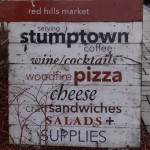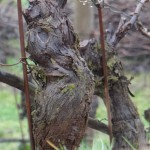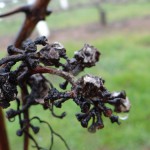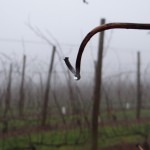In March 2014 I was in the Oregon wine country, touring tasting and learning. Lea rning a lot. I drove north from Salem towards Dundee, and at first I felt that the wine country was quite similar to Long Island but boy was I wrong. Yes, there were flat places and a maritime climate. Yes, there were sod farms and farm stands with local produce but that is about where it ends. What I thought were apple trees were filbert trees, where on Long Island there would be flat land at every
rning a lot. I drove north from Salem towards Dundee, and at first I felt that the wine country was quite similar to Long Island but boy was I wrong. Yes, there were flat places and a maritime climate. Yes, there were sod farms and farm stands with local produce but that is about where it ends. What I thought were apple trees were filbert trees, where on Long Island there would be flat land at every 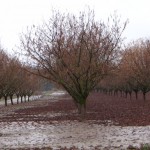 turn in the Willamette Valley a turn off the road can lead up a steep hill.
turn in the Willamette Valley a turn off the road can lead up a steep hill.
The maritime climate was showing at its peak with grey skies, a deep dense fog and a constant mist and light rain. It was cool and the damp March air was heavy, blanketing the vines as they rested for the winter. I was able to just see the faint outlines of the hills that surround the valley and the pine trees that tower over head with their commanding presence. Their beauty helped make this region unique.
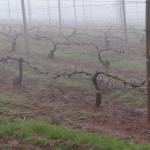
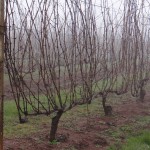 On Dundee hill various vineyard management philosophies were evident. At White Rose Winery: http://whiteroseestate.com/ the vines were trained very close to the ground to accommodate for the fog that often covers their vineyards. With some vines pruned and others still showing their canes the growth that takes place was evident. The pruned vines sat just inches from the ground but the canes shot up over six feet from the ground. I had seen this type of pruning before but only in books.
On Dundee hill various vineyard management philosophies were evident. At White Rose Winery: http://whiteroseestate.com/ the vines were trained very close to the ground to accommodate for the fog that often covers their vineyards. With some vines pruned and others still showing their canes the growth that takes place was evident. The pruned vines sat just inches from the ground but the canes shot up over six feet from the ground. I had seen this type of pruning before but only in books.
Just a few hundred yards away was Domaine Drouhin: 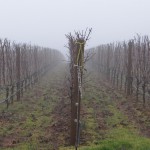 http://www.domainedrouhin.com/en/ and Archery Summit: http://www.archerysummit.com/, their properties are adjacent to each other but their planting styles are worlds apart. At Domaine Drouhin their vines are planted very close together, spaced about three feet apart and four feet wide. This dense planting results in more vines per acre than many of the surrounding vineyards but they tend to drop a significant amount of fruit leading to similar yields per acre.
http://www.domainedrouhin.com/en/ and Archery Summit: http://www.archerysummit.com/, their properties are adjacent to each other but their planting styles are worlds apart. At Domaine Drouhin their vines are planted very close together, spaced about three feet apart and four feet wide. This dense planting results in more vines per acre than many of the surrounding vineyards but they tend to drop a significant amount of fruit leading to similar yields per acre.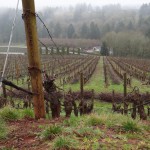 Archery is on the south side of the hill and uses wider planting and a north-south planting pattern.
Archery is on the south side of the hill and uses wider planting and a north-south planting pattern.
This is Pinot Noir country and the wines express their sites beautifully. Though, through all this Pinot Noir I was surprised to see chardonnay on the tasting menu at Domaine Drouhin. They use a Dijon clone and have had great success in this cool maritime climate. Earlier wine makers tried to use other clones with less success, Drohin, however, shows beautifully with a balance between a crisp French style and new world expressions.
My visit to Domaine Serene http://www.domaineserene.com/ was inspired by Prof. Roger Dagorn, MS. “A must see” he said and he was right. I found elegance here, not only in the wine but in the winery too. The lawn and winery are immaculate and all encompassing with a wrought iron mastodon on the lawn created by a local artist representing a time long gone. The wines I tried were the Evenstad Reserve, 2009 and 2012 Pinot Noir they had red fruits on the nose and pallet yet was beautifully spicy as well. The heat of the 2009 vintage was evident and will ensure the wine lasts for many years to come.
wine but in the winery too. The lawn and winery are immaculate and all encompassing with a wrought iron mastodon on the lawn created by a local artist representing a time long gone. The wines I tried were the Evenstad Reserve, 2009 and 2012 Pinot Noir they had red fruits on the nose and pallet yet was beautifully spicy as well. The heat of the 2009 vintage was evident and will ensure the wine lasts for many years to come.
My last visit was to The Four Graces http://thefourgraces.com/, a wine we use in the wine class to show the style of Oregon Pinot Gris. Unlike the previous wineries the tasting room for Four Graces is on the valley floor at the edge of the town of Dundee. The tasting experience here was warm and friendly, relaxed yet intense with site specific details. Here I did not stay with only Pinot Gris and Pinot Blanc from their various vineyards but of course tried their Pinot Noirs as well. Of outstanding mention was the Black Family Estate wines http://thefourgraces.com/vineyards/black-family-estate-vineyard.html. Though they are labeled as Willamette Valley they are predominately Dundee. This was among the most full body of the Pinots I tasted on this day and well worth my final stop.
As in many wine producing areas locally sourced food is of great importance. If you ever do get a chance to visit the Willamette Valley be sure to have lunch at Red Hills Market http://www.redhillsmarket.com/. They offer local food at great prices. The roasted ham sandwich with honey butter and melted gruyere was a treat as was the salad made with those local filberts that seem to be everywhere. Finish with a Stumptown coffee and then head back to Portland.
So, as I sit and write this post I am happy to add another wine region to my travels, another experience spent talking to people with passion and a deep understanding of their vineyards and wine. I love that in so many of the wine regions I have traveled there is outstanding locally sourced food and art that inspires. Wine has a way of bringing the best of what is available to one place and that is evident in Willamette Valley.

